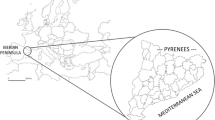Abstract
The incorporation of suitable quantitative methods into ethnobotanical studies enhances the value of the research and the interpretation of the results. Prediction of sample species richness and the use of species accumulation functions have been addressed little in applied ethnobotany. In this paper, incidence-based species richness estimators, species accumulation curves and similarity measures are used to compare and predict species richness, evaluate sampling effort and compare the similarity of species inventories for ethnobotanical data sets derived from the trade in traditional medicine in Johannesburg and Mpumalanga, South Africa. EstimateS was used to compute estimators of species richness (e.g. Jackknife), rarefaction curves, species accumulation curves and complimentarity. Results showed that while the Michaelis–Menten Means estimator appeared to be the best estimator because the curve approached a horizontal asymptote, it was not able to accurately predict species richness for one of the data sets when two of its subsamples were individually tested. Instead, the first-order Jackknife estimator best approximated the known richness.
Similar content being viewed by others
References
Begossi A (1996) Use of ecological methods in ethnobotany. Econ Bot 50:280–289
Bunge J, Fitzpatrick M (1993) Estimating the number of species: a review. J Am Stat Assoc 88:364–373
Botha J (2001) Perceptions of availability and values of medicinal plants traded on the western boundary of the Kruger National Park, South Africa. MSc dissertation, University of the Witwatersrand, Johannesburg
Chiarucci A, Enright NJ, Perry GLW, Miller BP, Lamont BB (2003) Performance of nonparametric species richness estimators in a high diversity plant community. Divers Distrib 9:283–295
Colwell RK (2001) EstimateS: statistical estimation of species richness and shared species from samples. Version 6. User’s guide and application published at: http://www.viceroy.eeb.uconn.edu/estimates
Colwell RK (2005) EstimateS: statistical estimation of species richness and shared species from samples. Version 7.5. User’s Guide and application published at: http://www.purl.oclc.org/estimates
Colwell RK, Coddington JA (1995) Estimating terrestrial biodiversity through extrapolation. In: Hawksworth DL (ed), Biodiversity, measurement and estimation. Chapman and Hall, pp 101–118
Colwell RK, Mao CX, Chang J (2004) Interpolating, extrapolating, and comparing incidence-based species accumulation curves. Ecology 85(10):2717–2727
Cunningham AB (1988) An investigation of the herbal medicine trade in Natal-Kwazulu. Investigational Report No. 29, Institute of Natural Resources, University of Natal, Pietermaritzburg
Cunningham AB (2001) Applied ethnobotany: people, wild plant use and conservation. People and Plants Conservation Manual, Earthscan, London
Dold AT, Cocks ML (2002) The trade in medicinal plants in the Eastern Cape Province, South Africa. South African J Sci 98(11–12):589–597
Gotelli NJ, Colwell RK (2001) Quantifying biodiversity: procedures and pitfalls in the measurement and comparison of species richness. Ecol Lett 4:379–391
Gotelli NJ, Entsminger GL (2001) EcoSim: null models software for ecology. Version 7.0. Acquired Intelligence Inc. and Kesey-Bear. http://www.homepages.together.net/∼gentsmin/ecosim.htm
Hanazaki N, Tamashiro JY, Leitão-Filho HF, Begossi A (2000) Diversity of plant use in two Caiçara communities from the Atlantic Forest coast, Brazil. Biodiv Conserv 9:597–615
Hayek LC, Buzas MA (1997) Surveying natural populations. Columbia University Press, New York
Heck KL, van Belle G, Simberloff D (1975) Explicit calculation of the rarefaction diversity measurement and the determination of sufficient sample size. Ecology 56:1459–1461
Höft M, Barik SK, Lykke AM (1999) Quantitative ethnobotany: applications of multivariate and statistical analysis in ethnobotany. People and Plants working paper 6. UNESCO, Paris
Krebs CJ (1989) Ecological methodology. Harper and Row, New York
Ludwig JA, Reynolds JF (1988) Statistical ecology—a primer on methods and computing. John Wiley and Sons, Toronto
Magurran A (1988) Ecological diversity and its measurement. Princeton University Press, Princeton
Magurran A (2004) Measuring biological diversity. Blackwell Publishing, Oxford
Pielou EC (1975) Ecological diversity. Wiley InterScience, New York
Soberón J, Llorente J (1993) The use of species accumulation functions for the prediction of species richness. Conserv Biol 7:480–488
Sørenson L (2004) Composition and diversity of the spider fauna in the canopy of the montane forest in Tanzania. Biodiv Conserv 13:437–452
Toti DS, Coyle FA, Miller JA (2000) A structured inventory of Appalachian grass bald and heath bald spider assemblages and a test of species richness estimator performance. J Arachnol 28:329–345
Williams VL (2003) Hawkers of health: an investigation of the Faraday Street traditional medicine market in Johannesburg, Gauteng. Plant Ecology and Conservation Series No. 15, University of the Witwatersrand (Report to the Gauteng Directorate for Nature Conservation, DACEL), p␣215
Williams VL, Balkwill K, Witkowski ETF (1997) Muthi traders on the Witwatersrand, South Africa – an urban mosaic. S Afr J Bot 63(6):378–381
Williams VL, Balkwill K, Witkowski ETF (2000) Unravelling the commercial market for medicinal plants and plant parts on the Witwatersrand, South Africa. Econ Bot 54(3):310–327
Williams VL, Witkowski ETF, Balkwill K (2005) Application of diversity indices to appraise plant availability in traditional medicinal markets in Johannesburg, South Africa. Biodiv Conserv 14:2971–3001
Williams VL (2005) Market networks for medicinal bark in southern Africa. In: Trees for health—forever: Implementing sustainable medicinal bark use in southern Africa. Regional Workshop, Johannesburg, South Africa, 1–3 November 2005. DFID-FRP Project R8305, UK
Author information
Authors and Affiliations
Corresponding author
Rights and permissions
About this article
Cite this article
Williams, V.L., Witkowski, E.T.F. & Balkwill, K. The use of incidence-based species richness estimators, species accumulation curves and similarity measures to appraise ethnobotanical inventories from South Africa. Biodivers Conserv 16, 2495–2513 (2007). https://doi.org/10.1007/s10531-006-9026-9
Received:
Accepted:
Published:
Issue Date:
DOI: https://doi.org/10.1007/s10531-006-9026-9




